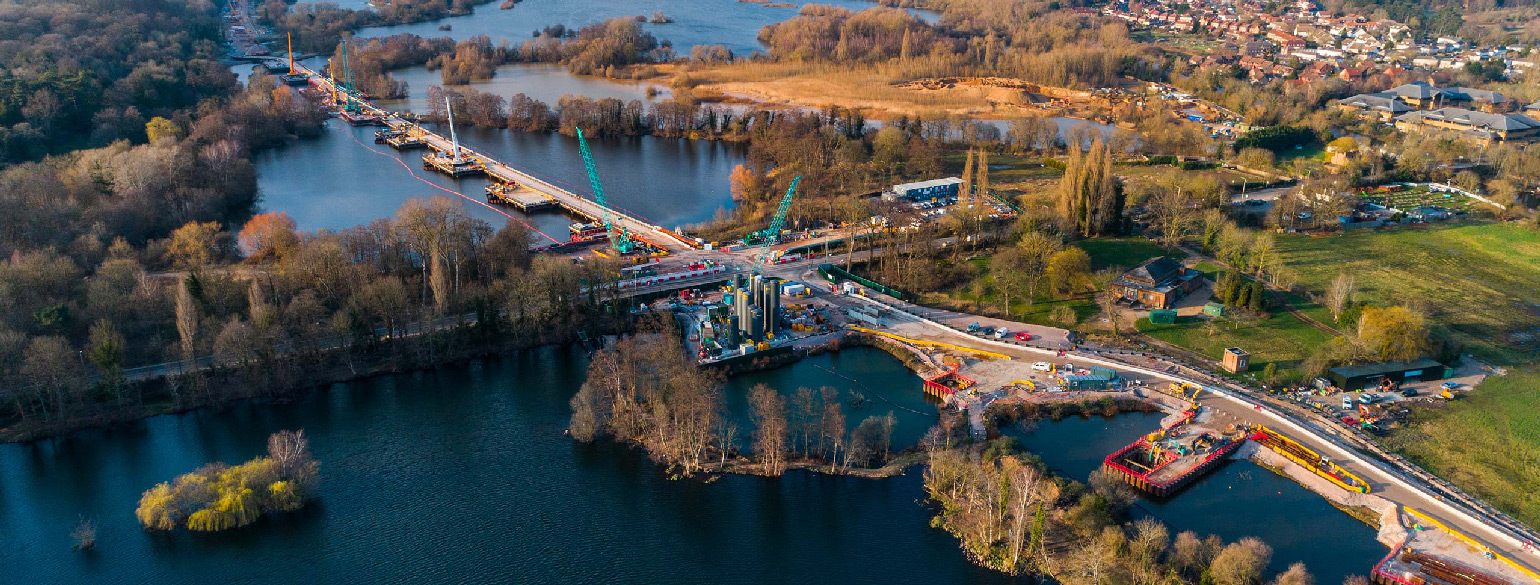
In Her Majesty’s (Express) Service
MAJOR PROJECT
Bouygues Travaux Publics and VSL, two Bouygues Construction subsidiaries, are at work in the London suburbs constructing the Central 1 (C1) portion of the UK’s second high-speed train line. Numerous innovations are playing an important role in this enormous undertaking.
By Isabelle GODAR
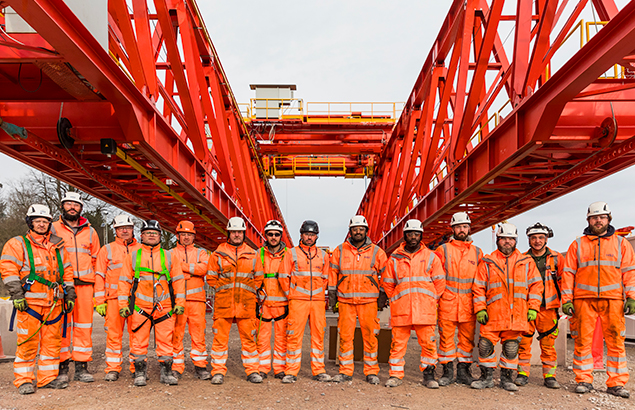
Of London and past the town of Uxbridge, the Colne Valley Regional Park and the Chiltern Hills offer the traveler nearly 70 kilometers of rolling landscape dotted with lakes, grain fields, houses with thatched roofs, forests of bizarrely shaped trees, and pubs with evocative names like The Green Man, The Red Lion, and Ye Olde Fighting Cocks. Hidden in this peaceful and, in places, wild countryside, one of the largest railway construction projects in Europe is underway, with its impact on the environment kept to a minimum. High Speed 2 (HS2), whose first phase will connect London and Birmingham, will be the UK’s second high-speed rail West line after High Speed 1, which runs between the Channel Tunnel and central London. A 21.6-km section of this new line is being built by Align, a joint venture of Bouygues Travaux Publics (60%), VolkerFitzpatrick (20%), and Sir Robert McAlpine (20%).
1The Green Man, The Red Lion and Ye Olde Fighting Cocks.
2500
employees at peak periods
3.4 km
viaduct
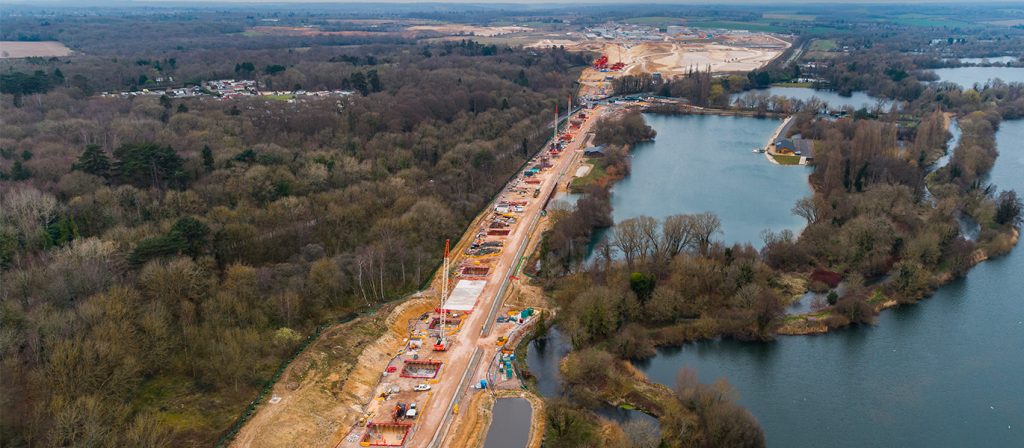
A COMPLEX PACKAGE
Winter is coming to an end, and on the South Portal site to the west of London and just inside the M25, London’s orbital motorway, over 2,000 workers are on the job. It is a very cosmopolitan group. People from many countries have been brought here to provide the broad range of skills and expertise in civil engineering and public works required for this colossal project. On this site, you can find two huge precast factories – one producing the tunnel segments and the other one deck segments for the viaduct. There are also three batching plants at this site, a Slurry Treatment Plant to process the 3 million cu. meters of spoil being excavated to form the tunnels along with a water treatment plant. These facilities are there to deliver the two main engineering structures in C1: a 16-km, twin-tube tunnel (project director Daniel Altier notes the length is “above average for most tunnels, which are normally around 5 to 10 kilometers long”) and a 3.4-km viaduct, soon to be the longest rail viaduct in the country, that will span several lakes.
Once complete, HS2 Phase One will connect London to Birmingham, England’s second-largest city, in less than one hour. Some 20 trains will make the trip each hour, transporting 300,000 passengers a week. HS2 Phase Two will continue after that to Manchester and the North. “HS2 will have a significant structural impact on the country since the objective is to develop regions in the north by facilitating freight transport,” explains Altier. The C1 package awarded to Align is exceptional in that it crosses protected natural areas. “It’s not the longest section,” says Altier, “but it’s by far the most complex technically because of the scale of the engineering structures being built and the environmental constraints.”
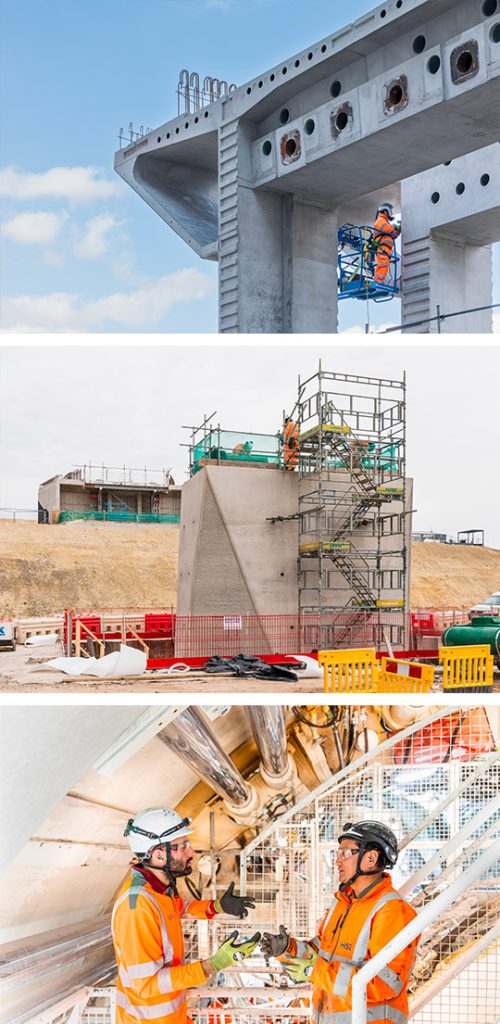
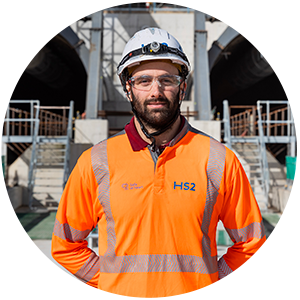
Tunnel construction is definitely the future because it allows infrastructure needs to be addressed while minimizing the impact on the local environment
Senior TBM Engineer for align
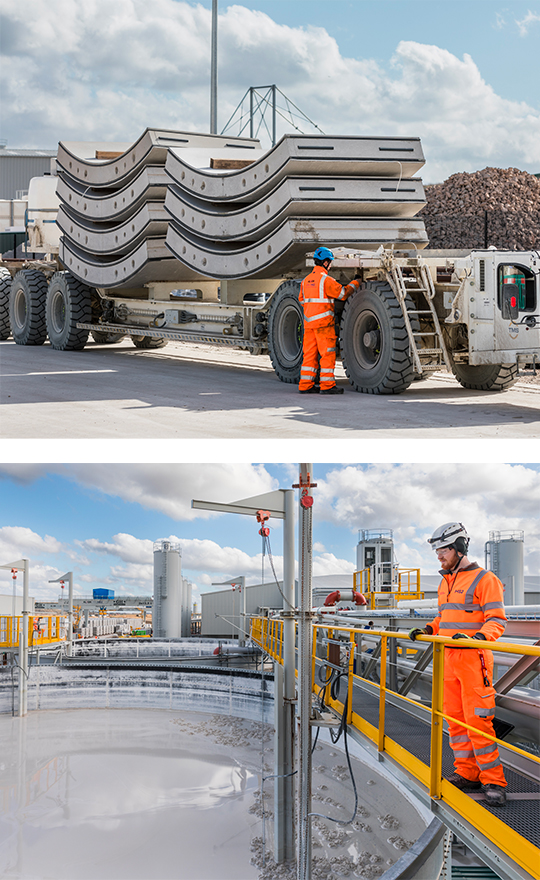
SUBTERRANEAN ROBOT
At the edge of the South Portal site, two tunnel entrances each 10 meters in diameter show where the tunnel boring machines Cecilia and Florence began excavating last spring. Both TBMs are well on their way, having each burrowed well over two miles. Operating 24 hours a day, seven days a week, and equipped with a semi-automated system for installing the tunnel lining segments, the TBMs are advancing at a rate of 20 to 30 meters a day. “That’s an exceptional pace,” according to Adrien Baudard, a TBM engineer working in the Align joint venture.
A team of 17 come on board each TBM to take over from the previous shift. Amidst the rumbling of the machines, they await the morning briefing. ″Florence and Cecilia incorporate the latest innovations in robotics,” says Didier Jacques, director for Tunnels and Shafts at Align. The Krokodyl robot, for example, has an automated arm that removes the wooden spacers between the curved concrete segments that form the tunnel lining before they are assembled. In the past, a worker would have had to go out, remove the spacer, and then get back into the TBM. “Robots make certain tasks, like lifting heavy loads, easier, and they reduce the need for personnel to go into hard-to-access places. That means they are kept out of harm’s way and able to focus on higher-value tasks,” explains Baudard.
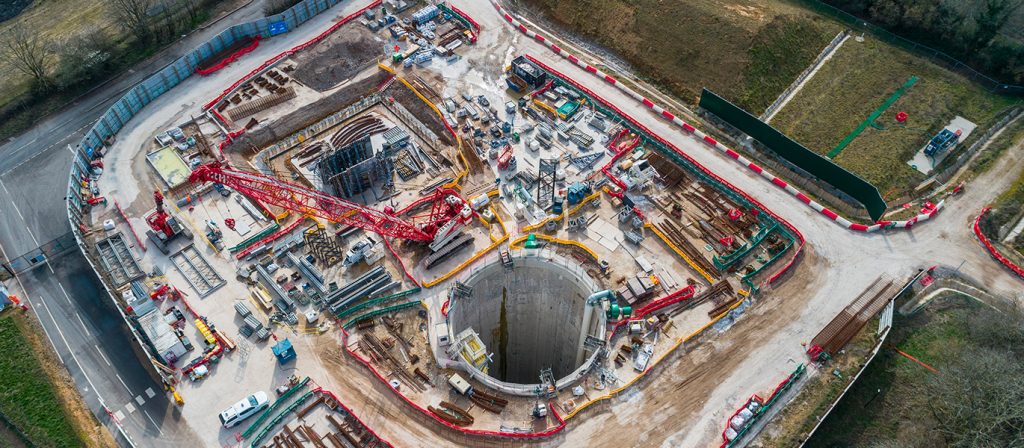
O2 and H20
As the TBMs excavate, water is pumped to the cutter head where it is mixed with the spoil to form a slurry, which is then pumped through a series of pipes that follow the TBMs back to the Slurry Treatment Plant at the South Portal site. “This is the most efficient way to extract the spoil”,” notes Baudard. The spoil, which predominantly consists of chalk and flint, is processed at the Slurry Treatment Plant, where the flint is removed and the chalk passes through filter presses to extract the water. Filter presses consist of stacks of plates covered with filter cloths that exert pressure to separate the solid particles from the water. ″With 24 filter presses in one location this is understood to be the largest facility of this kind operating anywhere across Europe,” boasts Christopher Prince, Slurry Treatment Plant engineer with Align. “We can recycle 100 percent of the water used by the TBM, since it flows in a closed circuit.” As for the chalk cakes, they are being used to landscape an area on the site known as Pynesfield Quarry. “Some 2.5 million tons of excavated earth will be used to create a chalk grassland in the Pynesfield Quarry area,” explains Baudard. Eventually, this area will be landscaped in a new nature reserve consisting of calcareous grasslands, which will be beneficial to biodiversity, wildlife, and nearby communities.
100%
des eaux utilisées pour le tunnelier sont recycler
Cecilia is cutting through the shaft near the village of Chalfont St Peter, the first of five shafts being constructed at intervals of approximately 2 miles to provide ventilation and emergency access for the tunnel. Significant work must be done at each shaft, including waterproofing and internal construction elements, before the TBM arrives. Adits will eventually be constructed that will connect the shafts to the tunnels. In addition an additional 38 cross passages are being constructed along the route which will connect both tunnels. Great care was taken digging the 78-meter-deep Chalfont St Peter shaft because nearby groundwater provides London with drinking water. “The diaphragm walls in the shaft are reinforced by membranes and waterproofed to prevent infiltration of water. This is essential to ensure the long-term integrity of the shaft,” explains Steve Meecham, a civil engineer with Align overseeing the construction of the shafts. Once internal ventilation and access elements have been installed, the “head house” will be constructed on the surface. Its design, which was approved by local stakeholders, resembles a barn to blend in with the local environment.
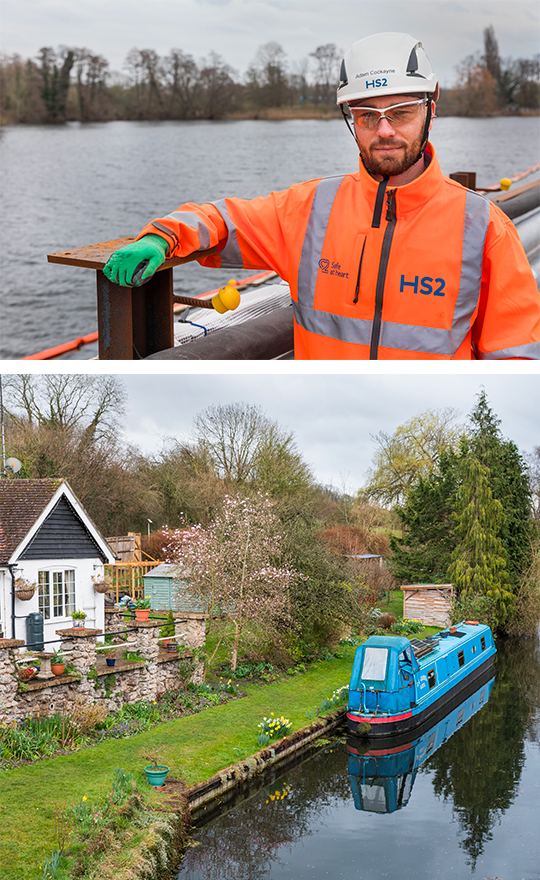
SKIMMING ACROSS THE WATER
Experts at VSL, a Bouygues Construction subsidiary, have come from the four corners of the world to install the launching girder that will be used to construct the viaduct deck. It will take no less than two years to lift into place the one thousand deck segments and apply the required post-tensioning. A jetty has been constructed across the lakes in the Colne Valley, creating a haul road for the construction of the 3.4-km viaduct that enables Align to keep construction traffic off local roads. To integrate the structure into its natural environment, the architects have chosen V-shaped piers to create the impression of a stone skimming across the water. ″A lot of attention was paid to the aesthetics of the bridge so that it would be more acceptable to people in the area. That made its construction a bit more complex,” says Martins Silickis, Jetty Package Manager. A prefabrication plant at the South Portal site is producing the 1,000 individual deck segments. Using the launching girder theses will be put in place on the 56 piers that are being constructed in situ across the Colne Valley on both land and across the lakes. To support the complex construction process, Align is using special software that keeps track of the 21,000 elements of the viaduct. Used by all project departments, this digital tool collects and analyzes data in real time to monitor quality and progress. HS2 is serving as a European laboratory of innovation and digitalization.
A wealth of innovations
“There have never been so many innovations involved in a tunnel project,” points out Nicolas Braud, director of Innovation and Big Data at Bouygues Travaux Publics. Two of them were developed jointly with Herrenknecht, the German manufacturer of tunnel boring machines and longtime partner of Bouygues Construction: a semi-automatic system for installing the tunnel segments that allows excavation to continue without interruption, and the suspended robot Krokodyl, which removes the spacers between the segments. Yet another innovation is an AI platform for planning operations developed by the US-based startup Alice Technologies.
vsl, a key partner
For the construction of the tunnel and the viaduct, VSL UK, partnering with Keller through the KVJV joint venture, has been in charge of ground engineering, performing pre- and post-works injections to soil dissolution and ground movements at the South Portal, the shafts, and the cross passages between the tunnels. At the ventilation shafts, it has installed the foundations with diaphragm walls up to a depth of 78 meters. KVJV is also constructing the 292 piles that form the foundations of the viaduct. VSL is operating the launching girder that will lift the segments of the viaduct deck into place, and it will install the post-tensioning, which will have the highest level of corrosion protection (PL3) and be monitored with an automated inspection system, the first time such a system has been used.
LOW-carbon transport and worksite
- The South Portal site is entirely run with HVO (hydrotreated vegetable oil), a type of biofuel produced from oil waste, reducing the carbon impact of the plants and transport by 90%
- The TBMs and the rest of the site are fully powered with green electricity
- The designs of the viaduct and tunnel have been optimized to lower carbon emissions by about 30% by reducing quantities of steel and concrete.